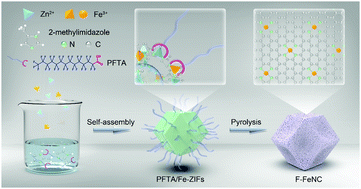Abstract
As the alternatives to expensive Pt-based materials for the oxygen reduction reaction (ORR), iron/nitrogen co-doped carbon catalysts (FeNC) with dense FeNx active sites are promising candidates to promote the commercialization of proton exchange membrane fuel cells. Herein, we report a synthetic approach using perfluorotetradecanoic acid (PFTA)-modified metal–organic frameworks as precursors for the synthesis of fluorine-doped FeNC (F-FeNC) with improved ORR performance. The utilization of PFTA surfactants causes profound changes of the catalyst structure including F-doping into graphitic carbon, increased micropore surface area and Brunauer–Emmett–Teller (BET) surface area (up to 1085 m2 g−1), as well as dense FeNx sites. The F-FeNC catalyst exhibits an improved ORR activity with a high E1/2 of 0.83 V (VS. RHE) compared to the pristine FeNC material (E1/2 = 0.80 V). A fast decay occurs in the first 10 000 potential cycles for the F-FeNC catalyst, but high durability is still maintained up to another 50 000 cycles. Density functional theory calculations reveal that the strongly withdrawing fluorine atoms doped on the graphitic carbon can optimize the electronic structure of the FeNx active center and decrease the adsorption energy of ORR intermediates.

- This article is part of the themed collection: Special issue in honour of Seth Marder


 Please wait while we load your content...
Please wait while we load your content...